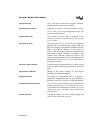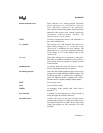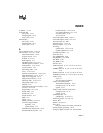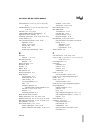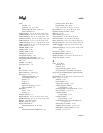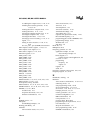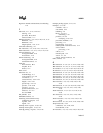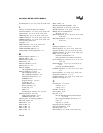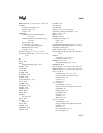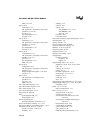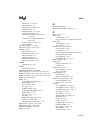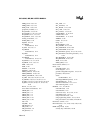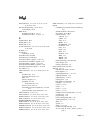
8XC196MC, MD, MH USER’S MANUAL
Index-4
re-enabling the compare event, 11-20, 11-22
reloading the waveform generator, 11-20,
11-23, C-16
resetting the timer in compare mode, 11-21
resetting the timers, 11-21, 11-23
selecting the capture/compare event, 11-19
selecting the compare event, 11-22
selecting the time base, 11-19, 11-22
selecting up or down counting, 11-16, 11-17
signals, 11-2
starting an A/D conversion, 11-20, 11-23,
C-16
See also port 1, port 6, PWM, timer/counters
EPA compare control x register, 11-22, C-15
EPA compare x time register, C-17
EPA control x register, 11-19, C-18
EPA time registers, C-21
EPA0_CON, C-68
EPA0_TIME, C-69
EPA1_CON, C-68
EPA1_TIME, C-69
EPA2_CON, C-69
EPA2_TIME, C-69
EPA3_CON, C-69
EPA3_TIME, C-69
EPA4_CON, C-69
EPA4_TIME, C-69
EPA5:0, 11-2, B-16
EPA5_CON, C-69
EPA5_TIME, C-69
EPTS instruction, 5-13, A-15, A-45, A-51, A-57
ESD protection, 6-3, 6-7, 13-5
Event processor array‚ See EPA
EXT instruction, A-2, A-15, A-41, A-47, A-52
EXTB instruction, A-2, A-16, A-41, A-47, A-52
EXTINT, 5-3, 14-7, B-16
and idle mode, 14-5
and powerdown mode, 14-6, 14-7
hardware considerations, 14-7
F
FaxBack service, 1-8
FE opcode
and inhibiting interrupts, 5-9
Floating point library, 3-4
Formulas
A/D conversion result, 12-9, 12-13
A/D conversion time, 12-7
A/D error, 12-11
A/D sample time, 12-7
A/D series resistance, 12-10
A/D threshold voltage, 12-5
A/D voltage drop, 12-11
capacitor size (powerdown circuit), 14-10
PH1 and PH2 frequency, 2-8
programming pulse width, OTPROM, 16-8
programming voltage, 16-15
SIO baud rate, 7-13
state time, 2-8
FPAL-96, 3-4
FREQOUT, B-16
Frequency generator, 8-1–8-9
application example, 8-4–8-9
data encoding example, 8-5
block diagram, 8-1
infrared remote control application, 8-5
overview, 8-1–8-2
programming
frequency, 8-3
output, 8-3
registers, 8-2
status, 8-4
Frequency generator count register, 8-4, C-22
Frequency register, 8-3, C-23
H
Handbooks, ordering, 1-6
Hardware
A/D converter considerations, 12-10–12-13
addressing modes, 3-5
auto programming circuit, 16-26
device considerations, 13-1–13-13
device reset, 13-8, 13-10, 13-11, 13-12
interrupt processor, 2-6, 5-1
memory protection, 16-7, 16-17
minimum configuration, 13-1
NMI considerations, 5-6
noise protection, 13-4
pin reset status, B-23, B-25
programming mode requirements, 16-13
reset instruction, 3-11
SIO port considerations, 7-8
slave programming circuit, 16-16
UPROM considerations, 16-7



